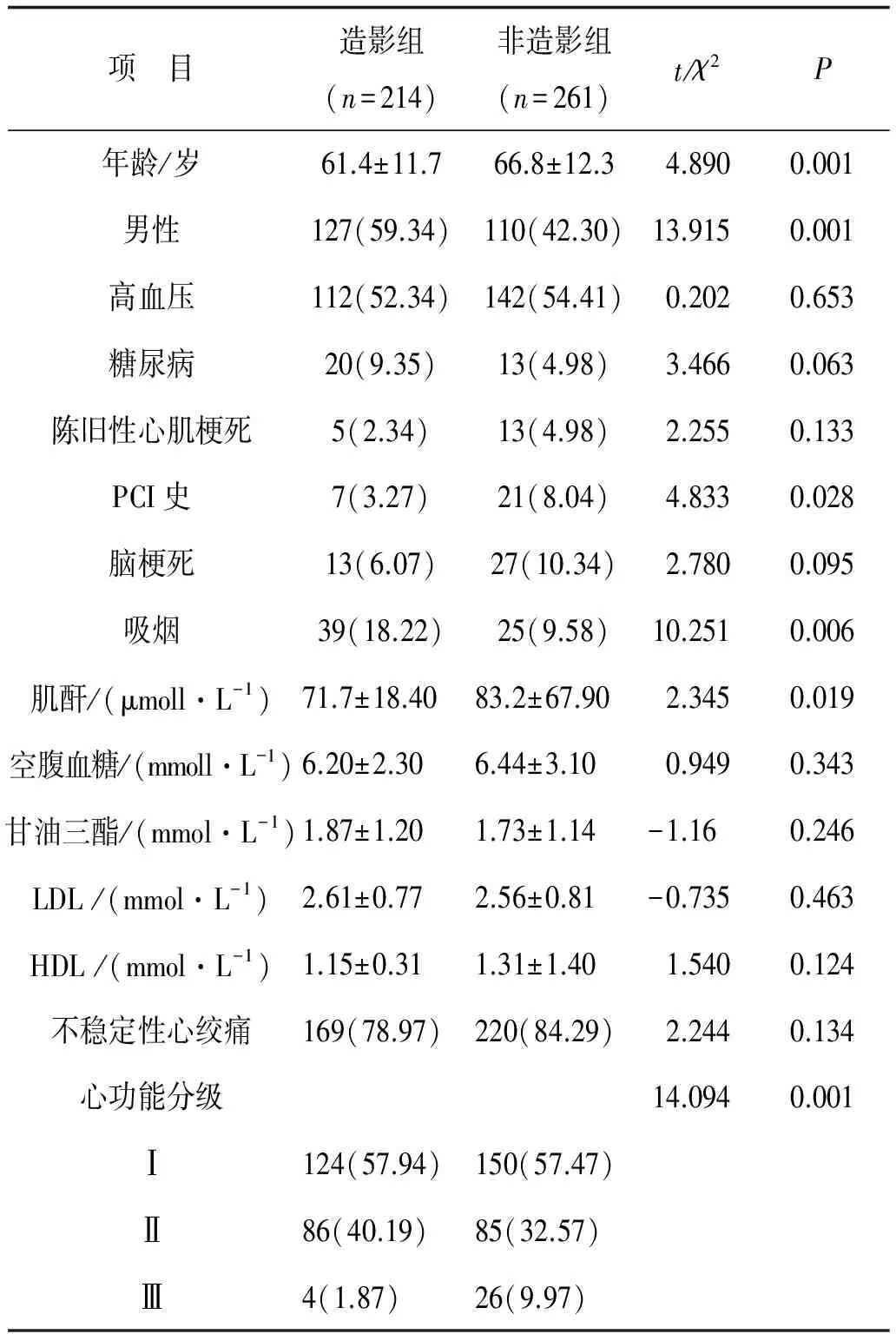非ST段抬高型急性冠脉综合征的冠状动脉造影影响因素
2017-04-01潘广杰张守彦马惠芳李松森
潘广杰,张守彦,马惠芳,金 军,李松森
非ST段抬高型急性冠脉综合征的冠状动脉造影影响因素
潘广杰,张守彦,马惠芳,金 军,李松森
目的 分析非ST段抬高型急性冠脉综合征(NSTE-ACS)患者选择冠状动脉造影的影响因素。方法回顾性收集2008年1月至2015年12月在我院出院的NSTE-ACS患者的临床资料,分为冠状动脉造影组与非造影组,比较两组间一般资料,多因素Logistic回归分析影响选择冠状动脉造影的因素。结果 冠状动脉造影组214例与非冠状动脉造影261例相比,男性、吸烟、心功能Ⅱ级比例较高,年龄、肌酐水平偏低。两组间高血压、糖尿病、陈旧性心肌梗死/经皮冠状动脉介入治疗、空腹血糖、甘油三酯水平差异无统计学意义。多因素Logistic回归分析显示男性、年龄、心功能Ⅱ级、肌酐水平是选择冠状动脉造影的影响因素。结论 本组NSTE-ACS患者冠状动脉造影率为45%,年龄、男性、心功能Ⅱ级、肌酐水平是选择冠状动脉造影的影响因素。
急性冠脉综合征;冠状动脉造影;心功能分级;年龄;男性
冠状动脉造影是诊断冠心病的金标准[1]。由于其费用较高、辐射量大、有一定的手术并发症,因此临床医师尽可能地选择合适的患者进行造影检查,提高诊断阳性率[2-3]。欧洲心脏病协会非ST段抬高型急性冠状动脉综合征(non-ST-segment elevation acute coronary syndrome,NSTE-ACS)指南建议对冠心病疑似患者进行危险分层,低危患者随诊观察,中危患者行运动负荷试验,高危患者直接冠状动脉造影检查[4]。然而,临床实践中,老年患者日趋增多,年龄因素干扰危险分层的判定,而且运动试验在老年患者中开展受阻[5]。作者回顾性分析我院NSTE-ACS患者的临床资料,探讨选择冠状动脉造影检查的影响因素,现报道如下。
1 资料与方法
1.1 一般资料 2008年1月至2015年12月在郑州大学附属洛阳市中心医院,以不稳定性心绞痛或非ST段抬高型心肌梗死为主要诊断的住院患者。每月出院的前5例,每年共60例,共收集480例,因部分病例数据缺失最终收集475例。
1.2 研究方法 收集性别、年龄、病史(高血压、糖尿病、高脂血症、脑卒中、陈旧性心肌梗塞(old myocardial infarction,OMI)、经皮冠状动脉介入治疗(percutaneous coronary intervention,PCI)、冠状动脉旁路移植术(coronary artery bypass grafting,CABG)、慢性肾脏病、吸烟、饮酒)、血脂、血糖、肌酐、心肌肌钙蛋白I(cardiac troponin I,cTNI)、冠状动脉造影结果等资料。不稳定性心绞痛患者的心功能分级采用NYHA分级,急性非ST段抬高型心肌梗死的心功能分级为Killip分级。因心功能IV级人数较少,将其纳入Ⅲ级组。以冠状动脉狭窄大于50%作为冠状动脉造影阳性的诊断标准[6]。将入选者分为冠状动脉造影组和非造影组,比较两组基线资料,使用多因素Logistic回归分析影响选择冠状动脉造影因素。
1.3 统计分析 正态分布的连续性变量,使用t检验,分类资料使用χ2检验。多因素Logistic回归分析冠状动脉造影的影响因素。P<0.05为有统计学意义。
2 结果
本组共475例,年龄(64±12)岁,最小30岁,最大92岁。其中,男性237例(49.89%)。不稳定性心绞痛患者386例(81.26%),急性非ST段抬高型心肌梗死患者89例(18.74%),两者之比为4∶1。死亡5例,院内死亡率1.05%,均发生在非造影组。其中1例心脏破裂,1例室颤,1例室速,2例合并房颤。冠状动脉造影45.05%(214/475)和非冠状动脉造影组54.94%(261/475)一般资料比较,见表1。
冠状动脉造影组中109例行经皮冠状动脉介入治疗,另外105例未行介入治疗。未介入治疗患者中,42例冠状动脉造影正常,63例至少单支冠状动脉狭窄50%以上。冠状动脉造影阳性率为80.37%。
将表1指标进行多因素Logistic回归分析,男性、年龄、心功能分级、肌酐水平是选择冠状动脉造影的影响因素(见表2)。


项 目造影组(n=214)非造影组(n=261)t/χ2P年龄/岁61.4±11.766.8±12.34.8900.001男性127(59.34)110(42.30)13.9150.001高血压112(52.34)142(54.41)0.2020.653糖尿病20(9.35)13(4.98)3.4660.063陈旧性心肌梗死5(2.34)13(4.98)2.2550.133PCI史7(3.27)21(8.04)4.8330.028脑梗死13(6.07)27(10.34)2.7800.095吸烟39(18.22)25(9.58)10.2510.006肌酐/(μmoll·L-1)71.7±18.4083.2±67.902.3450.019空腹血糖/(mmoll·L-1)6.20±2.306.44±3.100.9490.343甘油三酯/(mmol·L-1)1.87±1.201.73±1.14-1.160.246LDL/(mmol·L-1)2.61±0.772.56±0.81-0.7350.463HDL/(mmol·L-1)1.15±0.311.31±1.401.5400.124不稳定性心绞痛169(78.97)220(84.29)2.2440.134心功能分级14.0940.001Ⅰ124(57.94)150(57.47)Ⅱ86(40.19)85(32.57)Ⅲ4(1.87)26(9.97)
注:PCI:经皮冠状动脉介入治疗。LDL:低密度脂蛋白;HDL:高密度脂蛋白。

表2 多因素Logistic回归分析冠状动脉造影的影响因素
3 讨论
本组回顾性分析近8 a的NSTE-ACS患者的临床资料,能一定程度地反映实际临床诊疗情况。依据时间顺序,抽取每月出院的前5例病例资料,样本具有较强的代表性。研究结果显示214例接受冠状动脉造影,占45.05%,但是172例患者至少单支冠状动脉狭窄大于50%,即冠状动脉造影阳性率较高,占80.37%。
美国国家心血管病注册研究中纳入了663家医院,共398 978例未确诊冠心病的患者,结果显示冠状动脉造影阳性率为37.6%[6]。另一项研究纳入691家PCI中心的医院,共565 504例择期冠状动脉造影患者(除外已确诊冠心病),数据显示冠心病阳性率为23%~100%(中位数为45%,四分位间距39%~52%)[7]。其中91家(13%)医院冠状动脉粥样硬化阳性率小于35%,而82家(12%)医院冠状动脉造影阳性诊断率大于75%。本研究中冠状动脉造影阳性率接近上述研究的较高水平。这说明对冠状动脉造影指征的把握、控制较为严格。临床实践中应尽可能选取有危险因素、冠心病易患人群或心绞痛症状典型患者行冠状动脉造影检查[4]。
本组多因素Logistic回归分析显示年龄、男性、心功能分级、肌酐水平是影响选择冠状动脉造影的因素。首先,本研究汇总55~75岁较其他年龄段更易接受冠状动脉造影检查。这一年龄阶段是冠心病发病高危人群,该年龄段进行冠状动脉介入治疗的获益多,并发症相对少[8]。而在更高龄患者中,其合并症多,冠状动脉造影术后不良事件增多[9]。其次,心功能分级也是影响选择冠状动脉造影的重要因素。本研究显示心功能Ⅱ级以上患者更容易选择进行冠状动脉造影检查。这与欧洲心脏病学会指南推荐一致,心功能Ⅱ级以上患者劳累时心肌缺血症状加重,休息时缓解,是冠状动脉造影阳性的有效预测因子[4]。最后,肌酐水平较高者,较少选择进行冠状动脉造影检查。这可能与肾功能不全患者,造影剂肾病发生风险增加相关[10]。
本研究分析了影响选择冠状动脉造影的因素,以期对冠状动脉造影患者提供指导性意见。本组回顾性分析近8 a的NSTE-ACS患者临床病例资料,冠状动脉造影率为45%,年龄、男性、心功能Ⅱ级、肌酐水平是影响选择冠状动脉造影的因素。由于样本量的限制,部分患者病情危重需卧床休息,无法获得体质量,进一步计算肌酐清除率,以评估肌酐水平对NSTE-ACS患者的影响。
[1] Rezaei-Adaryani M,Ahmadi F,Mohamadi E,et al.The effect of three positioning methods on patient outcomes after cardiac catheterization[J].J Adv Nurs,2009,65(2):417-424.
[2] Kostakou PM,Damaskos DS,Dagre AG,et al.A safety radiation marker in the cardiac catheterization lab[J].Acta Cardiol,2016,71(2):145-150.
[3] Rio P, Ramos R, Pereira-da-Silva T,et al.Yield of contemporary clinical strategies to detect patients with obstructive coronary artery disease[J].Heart Int 2015,10(1): e12-e19.
[4] Roffi M,Patrono C,Collet JP,et al.2015 ESC guidelines for the management of acute coronary syndromes in patients presenting without persistent ST-segment elevation: task force forthe management of acute coronary syndromes in patients presenting without persistent ST-segment elevation of the European Society of Cardiology (ESC). [J].Eur Heart J,2016,37(3):267-315.
[5] Sun JL,Gao GL,Zhao Y,et al.Elderly patients and coronary heart disease on response to treadmill exercise test[J].Cell Biochem Biophys,2013,67(3):965-968.
[6] Patel MR,Peterson ED,Dai D,et al.Low diagnostic yield of elective coronary angiography[J].N Engl J Med,2010,362(10):886-895.
[7] Douglas PS,Patel MR,Bailey SR,et al.Hospital variability in the rate of finding obstructive coronary artery disease at elective,diagnostic coronary angiography[J].J Am Coll Cardiol,2011,58(8):801-809.
[8] Feldman DN,Gade CL,Slotwiner AJ,et al.Comparison of outcomes of percutaneous coronary interventions in patients of three age groups (<60,60 to 80,and >80 years) (from the New York State Angioplasty Registry)[J].Am J Cardiol,2006,98(10):1334-1339.
[9] Roth C,Gangl C,Dalos D,et al.Outcome after elective percutaneous coronary intervention depends on age in patients with stable coronary artery disease an analysis of relative survival in a multicenter cohort and an OCT substudy[J].PLoS One,2016,11(4):e0154025.
[10] Tsai TT,Patel UD,Chang TI,et al.Validated contemporary risk model of acute kidney injury in patients undergoing percutaneous coronary interventions:insights from the National Cardiovascular Data Registry Cath-PCI Registry[J].J Am Heart Assoc,2014,3(6):e001380.
Related Factors of Elective Coronary Angiography in Patients with Non-ST Segment Elevated of Acute Coronary Syndrome
PAN Guang-jie, ZHANG Shou-yan, MA Hui-fang, JIN Jun, LI Song-sen
(Luoyang Center Hospital Affiliated to Zhengzhou University,Luoyang 471000,China)
ObjectiveTo analyze related factors of elective coronary angiography in patients with non-ST segment elevated of acute coronary syndrome(NSTE-ACS).MethodsThe clinical data of NSTE-ACS patients were collected in our hospital from January 2008 to December 2015. The clinical information between coronary angiography group(n=214) and non coronary angiography group(n=261) were compared. The association factors of elective coronary angiography in multiple logistic regression mode were analyzed.ResultsCompared to non coronary angiography group(261 cases),the coronary angiography group(214 cases) had higher percentage of male,smoking and cardiac function grade Ⅱ,but had younger age and lower serum creatinine level. The percentage of hypertension,diabetes, chronic myocardial infarction/percutaneous coronary intervention, and fasting blood glucose, triglycerides level were no significantly statistic difference between the two groups. The male, age, cardiac function grade Ⅱ,and serum creatinine level were influence factors of elective coronary angiography in the multiple logistic regression mode.ConclusionThe elective coronary angiography rate was 45 percent in NSTE-ACS patients in our hospital.The male, age, cardiac function grade,and serum creatinine level were influence factors of elective coronary angiography.
acute coronary syndrom;coronary angiography;cardiac function classification;age;male
1672-688X(2017)01-0035-03
10.15926/j.cnki.issn1672-688x.2017.01.011
2016-12-17
郑州大学附属洛阳市中心医院,河南洛阳 471000
潘广杰(1971—),男,河南汝州人,副主任医师,从事心血管介入工作。
R543.3
B
